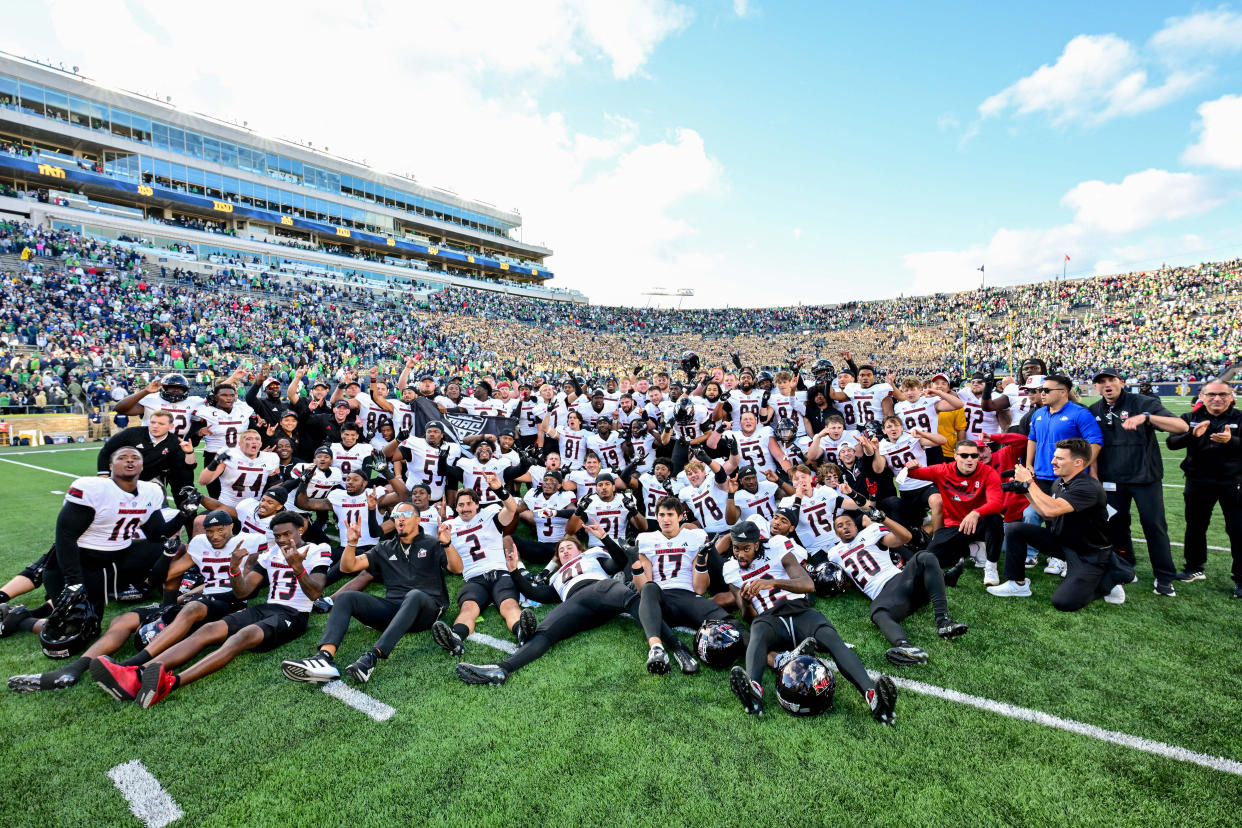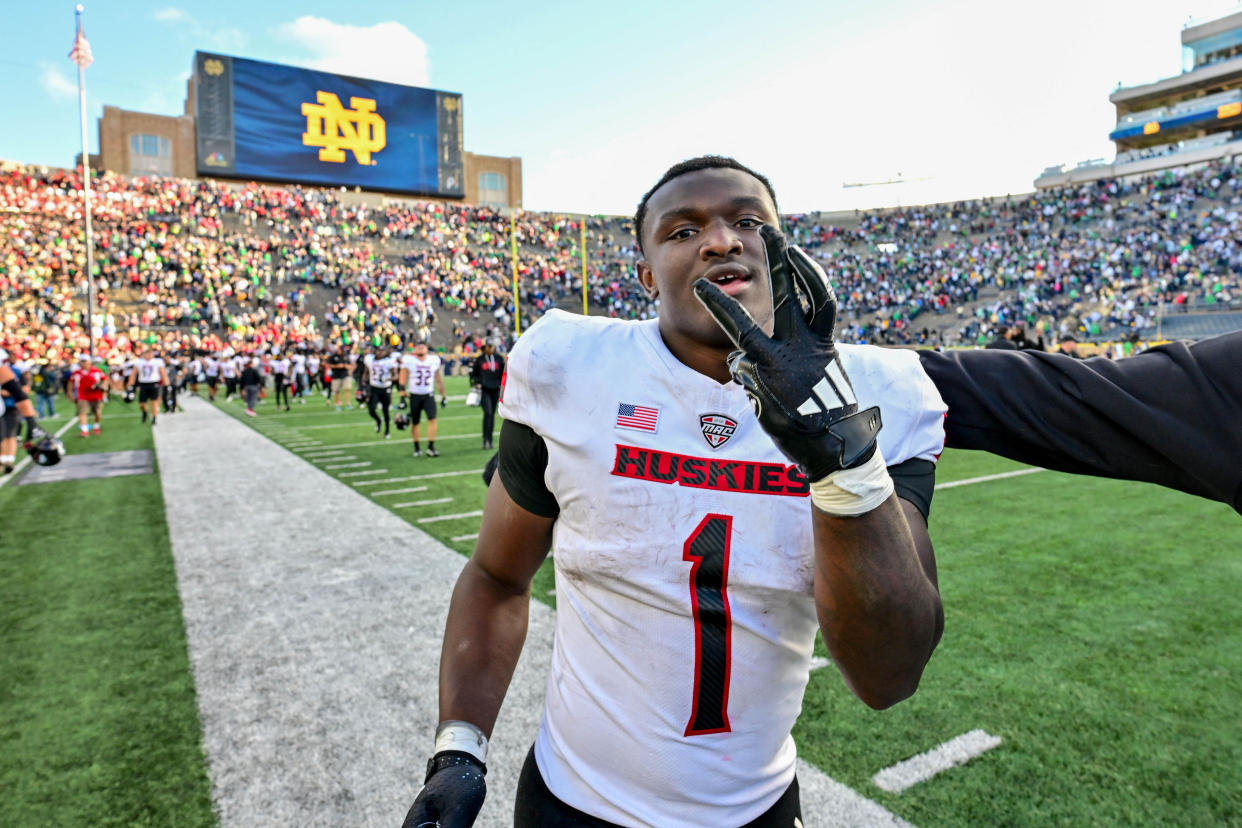NIU’s win over Notre Dame gave G5 schools glimmer of hope, but college football’s evolution may force more abrupt changes
Last December, after a long day of player meetings and bowl preparations, Thomas Hammock began to drive home with a terrible realization.
He’s leaving.
He is Antario Brown, the Northern Illinois all-conference running back who’d fielded enough high-dollar offers that he met with Hammock earlier that day and informed the Huskies' head coach he would be transferring to one of those power conference suitors.
This is a reality nowadays for many Group of Five football coaches: recruit an undervalued high school prospect, spend years developing him into an elite player and then see him leave for a bigger payday.
But this story, unlike many of the rest, ends differently.
Within a few minutes of Hammock arriving home that December day, Brown called with a change of heart: “I’m going to stay,” he told the coach.
Hammock, in his sixth year leading the NIU football program, tells the story as a way to provide a window into life in the G5, where retaining your best players is a constant battle against those with deeper pockets. He retraces the tale less than 48 hours after his Huskies thundered into Notre Dame Stadium for a 16-14 victory as four-touchdown underdogs — a game in which Brown was responsible for nearly 60% of NIU’s offensive yards.

In this transformative era of college athletics, the game is a reminder that the resource and recruiting gap between the haves and have-nots — perhaps as large as it’s ever been and growing — is not always an indicator of on-field results.
The lesson: Retain your best players and it’s possible for David to, every once in a while, smack Goliath.
The reality: Retaining your best players is becoming more and more difficult.
In fact, while Brown stayed, others left. Hammock lost a starting offensive lineman to Louisville and a starting defensive lineman to Florida in what the coach describes as “third-party situations.”
Such situations — tampering from a power school-affiliated collective or coaching staff — is quite common in the Mid-American Conference, says Jon Steinbrecher, the league’s longtime commissioner and a leading member on NCAA governance committees.
“In July, we had one of the most remarkable football coaches meetings I’ve ever had,” he told Yahoo Sports in an interview this week. “I heard story after story about tampering. I heard this story about a school out West. Recruited our kid, got him to transfer and then they offered him an additional bonus if he got his teammate to transfer as well. That’s the crazy stuff going on that is flat-out wrong.”
Steinbrecher declined to name the “school out West.” In this most recent cycle, MAC teams lost 42 players to power conference teams. Nine of the 12 schools lost at least three players to upper-tier programs. Steinbrecher has encouraged MAC coaches to gather evidence of tampering so he can pass such evidence on to the NCAA’s enforcement staff.
(Subscribe to College Football Enquirer on Apple Podcasts, Spotify, YouTube or wherever you listen.)
Harsh reality for many G5 schools — 'It’s a hopeless feeling'
In all, more than 150 players from the Group of Five moved to the Power Four with one year of eligibility remaining, choosing to play their final season at the major league level.
“Anybody who is 6-foot-5 is gone, even if it’s to join (power conference) scout teams. If you’re a 6-1 corner, you’re gone. You lose your best players,” former Akron and UL-Monroe coach Terry Bowden told Yahoo Sports this spring.
“It’s a hopeless feeling,” said SMU coach Rhett Lashlee, whose school moved from G5 American to P4 ACC this year.
It’s why it’s so surprising that Northern Illinois is able to retain enough players to knock off an opponent like Notre Dame.
“It’s remarkable they’ve been able to hold on to their roster,” Steinbrecher said. “The teams that can do that are going to have something special.”
Northern Illinois’ collective — the Boneyard Victor E. — has done enough in retention despite generating a small fraction of those in power conferences. The annual budget is on par with many G5 collectives, between $500,000 to $1 million, says Jason Belzer, the founder of SANIL (Student Athlete NIL), an organization that manages more than 50 collectives across the nation, including the Boneyard.
The Huskies' NIL football budget, Belzer notes, is likely a smaller figure than what many power conference collectives pay a single player. But in the Group of Five, “it’s all about retention,” he said.
The Huskies returned about 15 starters and have 35 seniors. A whopping 21 of those seniors have been on the roster since their freshman year — a figure that school administrators believe to be the third-highest such number of any program in the country (behind only Stanford and Navy).
In this age of increased player movement, maybe there should be a new statistic for such a figure: the Retainment Number.
“There are still people who believe in loyalty,” Hammock says. “There are still people who stick with you after you’ve stuck with them.”
And there are others chasing transactional relationships, some of which don’t always end well.
“We’ve had kids in the portal and they are in other places right now and they are kicking themselves,” said Northern Illinois athletic director Sean Frazier. “They hate it. It’s the NFL model.”
Hammock leans on love, he says. And though that sounds cliche, he means it. It’s the first thing he said when Brown walked into his office about transferring: “I love you,” he told his running back. Hammock is the only coach on staff who can make a formal offer to a recruit. That usually comes with a requirement of multiple in-person meetings with that recruit.

In a college football world evolving more into a transactional business, can Hammock’s approach truly work? For the Group of Five, a division with little NIL funding, is it a way forward?
“If I want it to be transactional, I’ll go back to the NFL,” said Hammock, who spent five years with the Baltimore Ravens. “I know what that is. I’m looking to have an impact on young people.”
But love can only go so far. Love can’t pay for rent or buy mom a new car.
In the MAC, the tampering is rife. Each December is a frantic few weeks as the transfer portal opens.
“The amount of slipping into the DMs…,” Frazer said. “But if you’re just going to buy your players and a roster, you’re not going to have that connection that we have here.”
Is it the love that keeps players going? It’s certainly not money — not here.
Those in the collective space suggest that the highest-paid Notre Dame player might be making per month what the highest- paid NIU player earns in a year ($30,000-50,000).
“We — the media and general public and practitioners — spend a lot of time focused on what people have and don’t have,” Steinbrecher said. “At the end of the day, you have to play the game. That’s the beauty of it.”
What is the path forward for G5 schools?
So how long will they — power conference programs — play these games?
It is a long-discussed topic — those from the SEC, Big Ten, ACC and Big 12 arranging their schedules to only play one another in more made-for-TV matchups. With the industry on the cusp of direct athlete compensation, the idea continues to generate more interest — some of it fueled by outside entities (think private equity) that wish to create more games featuring the big brands.
For Group of Five programs, games against power leagues, while also providing national exposure, generate millions in game fees. With an annual budget of $25 million, Northern Illinois’ fee from Notre Dame for Saturday’s game — $1.4 million — helps cover expenses.
The fear exists that one day — perhaps in the not-so-distant future — power league teams will adjust their schedules to remove many or all G5 programs, will compete all together in a different subdivision and/or will hold their own championship.
One of those who has been most public about that fear is, coincidentally, Frazer, a man who even years ago led an effort to create a G5 playoff, an idea that is resurfacing in light of the financial challenges between the Group of Five and power conferences.
He’s a realist about what happened Saturday in South Bend.
“It’s a great story if you can get the essence of the secret sauce,” he said. “But let’s face it: We are one of the few unicorns that can do something like this.”
Frazier believes the Group of Five needs to be more proactive in determining its future before it is determined for them through decisions by the power conferences. One of the first steps, G5 leaders say, came in the spring when the power conferences created a new CFP revenue-distribution model that left those in the Group of Five at a financial disadvantage.
But what does proactive mean exactly? In a meeting in Dallas last month, G5 commissioners discussed possibilities, including a four- or eight-team NIT-like football tournament featuring G5 teams and played in bowl games each December, as well as more of a regional schedule around their Olympic sports.
“People don’t want to hear about doing your own tournament or our own championship,” Frazier said. “People don’t like the NIT model. They have all these hangups. But let’s be proactive. If we’re trying to hide the cards … let’s be self-aware. We don’t have any cards. We have to get past that. We need to do something sooner than later. We know that a lot of us aren’t going to be able to do the rev-share.”
Steinbrecher declines to discuss G5 possibilities and keeps private the discussions that commissioners are holding, except to say that they are “examining” the early season window such as Week Zero as well as the postseason.
“I don’t know what that looks like,” he said. “This time of year, everybody wants to play in bowl games. When we get to the end of the season, there are opt-outs. What can we do that is different?”
In the meantime, Hammock and his staff will continue to lean on love. They’ll keep battling power conference programs to keep their best players. And, perhaps, they’ll pull more stunners before this year is up — maybe in the College Football Playoff.
With its win in South Bend, Northern Illinois captures what could very well be the best victory this season of any Group of Five program — a deciding factor in the CFP selection committee’s deliberations in December. The highest-ranked G5 champion gets an automatic spot in the expanded field, where they are almost assured of playing a power conference opponent on the road.
Sound familiar?


